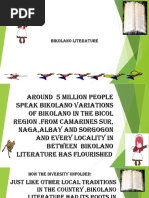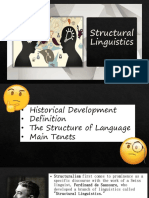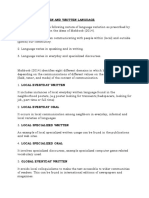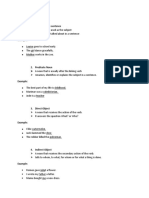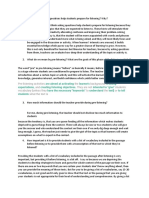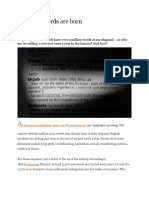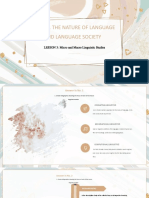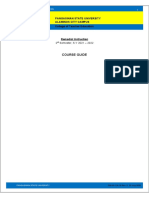Study Guide 5
Study Guide 5
Uploaded by
Darlene Joy CambayCopyright:
Available Formats
Study Guide 5
Study Guide 5
Uploaded by
Darlene Joy CambayCopyright
Available Formats
Share this document
Did you find this document useful?
Is this content inappropriate?
Copyright:
Available Formats
Study Guide 5
Study Guide 5
Uploaded by
Darlene Joy CambayCopyright:
Available Formats
Study Guide in Teaching and Assessment of Macro Skills FM-AA-CIA-15 Rev.
0 10-July-2020
Module 4 – The Receptive Macro Skills - Reading
Module No. 5
The Receptive Macro Skills - READING
MODULE OVERVIEW
Enumerated below are topics that you need to study in this module.
1) Nature and Purposes of Reading
2) Reading Comprehension and Sub-Skills in Reading
3) Reading Techniques and Strategies
4) Approaches in Teaching Reading (Bottom-Up, Top Down, Interactive)
5) Goddell’s Reading Skills Ladder and Stages of Reading
6) Reading Program and the Good Reader
7) Lesson Design in Teaching Reading
8) Materials and Resources in Teaching Reading
9) Performance and Observation-Based Assessment in Teaching Reading
10) Feedbacking in Assessing Reading
MODULE LEARNING OBJECTIVES
At the end of the lesson, the students will be able to:
a) select differentiated learning tasks in teaching reading to suit learners’ gender, needs, strengths
interests, and experiences;
b) demonstrate how to provide timely, accurate, and constructive feedback to improve learner performance
in the different tasks in reading through simulations;
c) conduct a teaching demonstration of the assigned learning competencies in reading.
LEARNING CONTENTS
Nature of READING
Reading is as approach in a thinking process – one in which the student interacts with the textual
material and sorts, evaluates, and reacts to its organization and content. Numerous strategies for perceiving
patterns and structure within sentence are included. In addition, according to Nunan (2003) states reading is
fluent process of readers combination of word recognition, intellect and emotion interrelated with prior
knowledge to understand the message communicated. It means that the participants or the reader transfer
meaning from the text and give assessment from the text to understand the message communicated.
The other opinions about definition of reading is decoding written words so that the readers can
produce them orally. Similarly, Harris (1980:3) defines reading as the meaningful interpretation of written or
printed verbal symbols. This definition is also supported by Nunan (2003 : 68) who states that reading is a
fluent process of readers combining information from a text and their own background knowledge to build
meaning. The same way that reading requires the reader to focus attention on the reading materials and
integrate previously acquired knowledge and skills to comprehend what someone else has written. In addition
Caroline T. Linse (2005 ; 69), reading is a set of skills that involves making sense and deriving meaning from
the printed word. In order to read, we must be able to decode (sound out) the printed words and also
comprehend what we read.
PANGASINAN STATE UNIVERSITY 1
Study Guide in Teaching and Assessment of Macro Skills FM-AA-CIA-15 Rev. 0 10-July-2020
Module 4 – The Receptive Macro Skills - Reading
Purposes of READING
Reading is an activity with a purpose. A person may read in order to gain information or verify existing
knowledge. A person may also read for enjoyment, or to enhance knowledge of the language being read.
Reading also plays an important role in civic life. Through reading, the individual keeps informed on the
political, social, and economic and cultural problems of his country. Reading affects our attitudes, beliefs,
standards, morals, judgments, and general behavior; it shapes our thinking and our actions. The purpose of
reading is to correlate the ideas on the text to what you have already known. The reader must understand
about the subject that he/she read to connect the ideas.
According to Grabe William and L. Fredrika (2002), the category of purpose for reading includes are:
reading to search for simple information, reading to skim quickly, reading to learn from text, reading to
integrate information, reading to write, reading to critique texts and reading for general comprehension.
a) Reading to search for simple information
Reading to search for simple information is a common reading ability, though some researchers see
it as a relatively independent cognitive process. It is used so often in reading tasks that is probably
best seen as type of reading ability.
b) Reading to skim quickly
Reading to skim quickly is a common part of many reading task and a useful skill in its own right. It
involves, in essence, a combination of strategies for guessing where important might be in the text,
and then using basic reading comprehension skills on those segments of the text until a general idea
is formed.
c) Reading to learn from text
Reading to learn typically occurs in academic and professional contexts in which a person needs to
learn a considerable amount of information from a text, it requires abilities to remember main ideas,
recognize and build rhetorical frames and link the text to the reader base.
d) Reading to integrate information
Reading to integrate information requires additional decision about the relative importance of
complementary, mutually supporting or conflicting information and likely restructuring of a rhetorical
frame to accommodate information from multiple sources.
e) Reading to write and reading to critique texts
Reading to write and reading to critique texts may be task variants of reading to integrate information.
Both require abilities to compose, select, and critique information from a text.
f) Reading for general comprehension
Reading for general comprehension when accomplished by a skilled fluent reader, require very rapid
and automatic processing of words, strong skills in forming a general meaning representation of main
idea, and efficient coordination of many processes under very limited time constraint.
Purposes of reading are not only for students, but also the people in general. They must read
extensively to get information and knowledge of social living. It can help a person keeps informed on the
social, political, and economical problems of his country.
Reading Comprehension and Sub-skills in Reading
Reading Comprehension
Comprehension refers to the ability to understand written words. It is different from the ability to recognize
words. Recognizing words on a page but not knowing what they mean does not fulfill the purpose or goal of
reading, which is comprehension. Imagine, for example, that a teacher gives a child a passage to read. The
child can read the entire passage, but he or she knows nothing when asked to explain what was read.
PANGASINAN STATE UNIVERSITY 2
Study Guide in Teaching and Assessment of Macro Skills FM-AA-CIA-15 Rev. 0 10-July-2020
Module 4 – The Receptive Macro Skills - Reading
Comprehension adds meaning to what is read. Reading comprehension occurs when words on a page are
not just mere words but thoughts and ideas. Comprehension makes reading enjoyable, fun, and informative.
It is needed to succeed in school, work, and life in general.
❖ Reading comprehension is essential for successful functioning in our society. In virtually all instances,
the goal of reading is to identify the meaning or message of the text at hand.
❖ Reading comprehension requires the reader’s active extraction and construction of meaning from text.
Many factors can influence the reader’s comprehension of text, including the other components of
proficient reading and the instruction they receive. Children’s spoken language skills provide a
foundation for proficient reading comprehension but, in the absence of effective instruction, are not
sufficient for developing proficient literacy. Vocabulary, for example, is one of the stronger predictors of
reading comprehension. Children may have the decoding skills required to read an unfamiliar word, but
if the word is not part of their lexicon, they may not be able to attach meaning to the decoded text. On
the other hand, if they cannot decode the word to begin with, their vocabulary skills will not help them
understand what they are reading.
❖ Reading comprehension is the process of simultaneously constructing and extracting meaning through
interaction and engagement with print. The success of a comprehension event depends on a good
match of reader skills, text difficulty, and task definition. Reader skills of vocabulary and background
knowledge are particularly important. Tasks are defined differently by the demands of different texts
(e.g., fiction vs. nonfiction), by different cultures, and by different disciplines. Approaches to
comprehension instruction cannot ignore basic word-reading skills for struggling readers, but can
usefully promote active engagement with varied texts, in both oral and literate modes, in pursuit of
authentic learning goals.
Sub-skills in Reading
Scanning: Spratt, et al. (2011) state that scanning refers to searching for specific information within a
text, where a quick glance is taken to find the relevant information without reading the whole text.
Skimming: Krashen & Terrell (1998) mention that this reading sub-skill follows scanning in the way it is
performed, which means a quick glance to extract superficial information of a text without major details,
but instead of trying to find specific words or information if focuses on the general essence of the different
parts or sections of a text. Spratt, et al. (2011) says that this sub-skill is also known as reading for global
understanding. Additionally, it could be said that scanning and skimming complement each other since
many times it is necessary to find specific elements that reveal the gist or main idea of a text; nevertheless,
each could be used independently to achieve the desired or required goal.
Extensive Reading: Yamashita (2015) identifies this sub-skill as that where great quantities of easy and
interesting reading materials are consumed, allowing the reader to enjoy reading and to read quickly
which leads to the high volumes of consumption. This pleasure reading is mostly done out of the
enjoyment of discovering and learning from the text. Yamashita (2008) reveals that it is possible to
increase automaticity of lower-level processes through extensive reading due to the quantity and repeated
exposure to the language that fosters their development. Likewise, strategy use here amplifies reading
pleasure and comprehension.
Intensive Reading: Spratt, et al. (2011) describe it as the opposite of extensive reading, where general
comprehension is not the focus and examining and studying the language takes center stage, which is
also called reading for detail. Hatami & Asl (2017) add that intensive reading consists in extracting specific
linguistic elements from short portions of text; which means that the text is used as a linguistic object to
analyze grammatical patterns as well as particular and concrete lexical items.
PANGASINAN STATE UNIVERSITY 3
Study Guide in Teaching and Assessment of Macro Skills FM-AA-CIA-15 Rev. 0 10-July-2020
Module 4 – The Receptive Macro Skills - Reading
Reading Techniques and Strategies
Reading strategies and techniques can help students to become excellent readers during any school year.
Through active reading and other methods, kids can increase their vocabulary and proficiency. Reading
techniques benefit struggling students and offer them constructive ways to get a better grasp on learning
how to read.
Reading strategies are specific procedures that help students look at printed words and interpret their
meaning. Learners improve their comprehension, understand what they've read and advance their reading
skills into high school and beyond.
There are several effective reading strategies designed to boost students' understanding of the written word:
1) Making connections — Connect new words with students’ prior knowledge and favorite hobbies,
activities or places they've visited. Use texts that relate to world issues to provide students with another
way to deepen their reading comprehension.
2) Inferencing— When reading the text, students take their past knowledge and arrive at a conclusion based
on the clues they receive from what they've read.
3) Synthesizing — Students combine new information with their prior knowledge to formulate a new thought
or idea.
Most people look at reading as a basic skill learned in elementary school. However, reading encompasses
much more than knowing how to pronounce words correctly. It involves reading comprehension skills and
overall understanding.
Students who continue to struggle with comprehension difficulties may fight to cope with:
• Poor vision
• Hearing loss
• Decoding problems
• Loss of concentration
• Learning disabilities, such as dyslexia, ADD or ADHD
• The inability to understand what specific words mean on their own or when used in a sentence
There is help available to students so that they can learn how to read effectively.
Here's a list of six reading comprehension skills that teachers can use to help their students develop these
abilities:
DECODING
Decoding or phonemic awareness is the first skill you learn when you go to school. It is the ability to make
out words, phrases, and sentences. It is a foundational reading skill that uses phonetics to understand
meaning. Students begin by pronouncing words without having seen how it's spelled. Building phonological
awareness facilitates the use of rhyming, sounds, and songs, which can in turn help students use decoding
strategies.
If you are a high school student or you’ve already embarked on your college journey, you are employing the
skill of decoding unconsciously. You need this skill to be a critical reader. For example, you may stumble
upon an unknown word while you are reading. You don’t know its meaning, but you do know how to
pronounce it by decoding the letters and the sounds they make when they are arranged in a specific order.
PANGASINAN STATE UNIVERSITY 4
Study Guide in Teaching and Assessment of Macro Skills FM-AA-CIA-15 Rev. 0 10-July-2020
Module 4 – The Receptive Macro Skills - Reading
VOCABULARY RANGE
Using your vocabulary knowledge means you can decipher meaning from the words and phrases you’re
reading. You should improve your vocabulary regardless of your age or education level.
Language is a living thing, which means that new vocabulary is being invented and acquired naturally all the
time. Whether you are a straight-A student or are struggling to break through your reading barriers, your
vocabulary should be evolving constantly.
Vocabulary is also closely related to concept development. What this means is that the richer your vocabulary
is, the broader your understanding of the world is. Vocabulary isn’t just a skill that helps you become a
proficient reader, but it can also improve your prospects of studying any given major.
FLUENCY
The greatest obstacle to fluency is word recognition. It can take several tries before a student recognizes a
word and knows its meaning. Encourage your students to read books often to build their reading fluency.
Reading fluency means you can read any text without difficulty, regardless of whether you are familiar with
the topic or not. Fluency in reading is reflected in how much you have to pause while reading to understand
what’s written.
A neat way you can gauge your reading fluency is by clocking your reading time. You don’t have to use a
stopwatch each time you sit down to enjoy a good book. You can instead time how many minutes it takes
you to get through a paragraph or even one sentence of an unfamiliar text.
LANGUAGE CONVENTION
Language conventions refer to your knowledge of grammar, spelling, and punctuation. While spelling words
correctly can fall under vocabulary skills, being familiar with various grammar constructions and standard
punctuation rules deserves a special mention.
If you can understand a text that has complex sentence structures, you possess one reading comprehension
skill. You can say that you possess this skill when you are comfortable with using more than several
grammatical constructions in your writing. This is one way in which writing and reading skills are
interconnected.
ATTENTION
Poor readers have short attention spans. They cannot focus on a lengthy passage without being distracted—
oftentimes, by their own thoughts. It’s why attention while being a cognitive skill essentially, is also a part of
proficient reading comprehension.
If you are struggling to focus on the text you are reading, you should practice broadening your attention span.
There are many ways to accomplish that. For example, you can set a specific time during the day that will be
devoted to reading. To get started, 15 minutes of uninterrupted reading is enough. See if, after several days,
you can broaden that timespan to 25 minutes or a whole hour.
Another cognitive skill that is relevant for reading is memory. Proficient readers won’t forget what they’ve
absorbed as soon as they are occupied by a different activity.
That is called retention, and not only does it help you study better, but it also lets you truly enjoy the reading
material and absorb new ideas from it.
WORLD KNOWLEDGE
Drawing on your background knowledge of the world is another skill you use unconsciously while you read.
PANGASINAN STATE UNIVERSITY 5
Study Guide in Teaching and Assessment of Macro Skills FM-AA-CIA-15 Rev. 0 10-July-2020
Module 4 – The Receptive Macro Skills - Reading
In practice, you are relating what you already know to what you are reading.
For example, let’s say you are reading Jane Austen’s classic “Pride and Prejudice.” The iconic opening
sentence goes, “it is a truth universally acknowledged, that a single man in possession of a good fortune,
must be in want of a wife.” Your knowledge of the period and its societal conventions helps you see that
Austen was poking fun at it.
The more you read, the more knowledge of the world you gain. You use the knowledge you acquired to infer
meaning from other texts. This is a good example of how you employ all the different reading skills
simultaneously.
Additional Reading Strategies
1. Identify the purpose in reading.
2. Use graphemic rules and patterns to aid in bottom-up reading.
3. Use different silent reading techniques for relatively rapid reading.
4. Skim the text for main ideas.
5. Scan the text for specific information.
6. Use semantic mapping or clustering.
7. Guess when you aren't certain.
8. Analyze vocabulary.
9. Distinguish between literal and implied meanings.
10. Capitalize on discourse markers to process relationships.
Approaches in Teaching READING
BOTTOM-UP APPROACH
Bottom-up strategies (or bottom-up processing): Bottom-up strategies incorporate the lower-level reading
processes that teach students to construct meaning from the most basic units of language, including letters,
letter clusters, and words. Students make meaning of a text by building on a foundation of analyzing the
smallest units of meaning.
Bottom-up reading strategies begin with letter-sound correspondences (the bottom) to achieve
comprehension (the top). Bottom-up processing begins with letters and sounds, building to morpheme and
word recognition, and then gradually moving to grammatical structure identification, sentences, and longer
texts. A phonics approach to teaching reading supports bottom-up processes. Phonics is a method to
facilitate students' access to text to ultimately lead to comprehension.
Bottom-up processing happens when someone tries to understand language by looking at individual
meanings or grammatical characteristics of the most basic units of the text, (e.g. sounds for a listening or
words for a reading), and moves from these to trying to understand the whole text. Bottom-up processing is
not thought to be a very efficient way to approach a text initially, and is often contrasted with top-down
processing, which is thought to be more efficient.
Example
Asking learners to read aloud may encourage bottom-up processing because they focus on word forms, not
meaning.
TOP-DOWN APPROACH
Top-down strategies (or processing): Top-down strategies instruction focuses on activities that construct
meaning rather than on mastering bottom-up skills. Students generate meaning by employing background
knowledge, making predictions, and searching the text to to confirm or reject the predictions that are made.
PANGASINAN STATE UNIVERSITY 6
Study Guide in Teaching and Assessment of Macro Skills FM-AA-CIA-15 Rev. 0 10-July-2020
Module 4 – The Receptive Macro Skills - Reading
According to supporters of this approach, comprehension resides in the reader. The reader uses background
knowledge, expectations, assumptions, and questions and engages in pre-reading strategies, such as
previewing the text, predicting, and activating background knowledge.
Top-down processing of language happens when someone uses background information to predict the
meaning of language they are going to listen to or read. Rather than relying first on the actual words or
sounds (bottom up), they develop expectations about what they will hear or read, and confirm or reject these
as they listen or read. Top-down processing is thought to be an effective way of processing language; it
makes the most of what the person brings to the situation.
Example
Asking learners to predict what a newspaper article might be about from the headline or first sentence will
encourage them to use top-down processing on the article.
INTERACTIVE APPROACH
The interactive approach is considered the most comprehensive description of the reading process. The best
readers use an interactive reading approach. An interactive approach to reading combines elements of both
bottom-up and top-down reading processes simultaneously. For example, a reader may begin reading a text
using top-down strategies to comprehend the text, and then shift to bottom-up strategies when he or she
encounters an unfamiliar word. The reader then uses bottom-up strategies to decode the new word before
moving on.
Another way to illustrate the interactive approach to reading is as follows: Recognition of letters (bottom-up
processes) leads to recognition of words, which leads to comprehension (bottom to top). Conversely, context,
inferences, and world knowledge (top-down processes) can influence lower-level processing strategies,
affecting readers' expectations about words and meanings and thus helping readers recognize words faster
(top to bottom).
Readers use both knowledge of word structure and background knowledge to interpret the texts they read.
For example, a student who encounters an unknown word might use surface structure systems like
graphophonic, or letter-sound, knowledge to decode the word. A different student might find it easier to use
deep structure systems like semantic knowledge, such as meaning and vocabulary, to decode the same
unknown word. Each student makes connections in different ways. This process validates and supports both
methods of understanding, realizing that individuals process information in very different ways.
In the classroom
Learners can be encouraged to use both bottom-up and top-down strategies to help them understand a text.
For example, in a reading comprehension learners use their knowledge of the genre to predict what will be in
the text (top-down), and their understanding of affixation to guess meaning (bottom-up).
Goddell’s Reading Skills Ladder and Stages of Reading
1) Sight words: Usually learned in 1st and 2nd grade. These are commonly used words that don’t need
to be sounded out because they don’t follow any specific rules. They must be learnt as sight words.
They are the base of reading and once they are memorised they can be instantly recognised when
reading. (eg. a, an, at, are, as, at, and, all)
2) Phonetic analysis: This is sounding out larger words by breaking them down into their
vowel/consonant/combination groups.
3) Structural analysis: This is breaking down parts of the word to understand what an unknown word
means.
4) Contextual clues: When children start reading they encounter many unfamiliar words. They can make
PANGASINAN STATE UNIVERSITY 7
Study Guide in Teaching and Assessment of Macro Skills FM-AA-CIA-15 Rev. 0 10-July-2020
Module 4 – The Receptive Macro Skills - Reading
use of the words they do know to give them clues of what the word near it might mean.
5) Vocabulary building: Our vocabulary is the words we understand and can communicate effectively. It
will continue to build as we read. Getting your child a dictionary, for whatever stage they’re in would be
very useful.
6) Finding the main idea: Identifying keywords in a sentence will allow them to build an idea. After a few
sentences, your child can then assume the direction of the story based on all the keywords or words
they do understand. Images in a book can also identify the main ideas.
7) Finding the supporting details: After finding the main ideas it will be easier to fill in the gaps. Word
webs can help your child connect ideas.
8) Interfering meanings and drawing conclusions: The meaning of a word can be implied by the general
context. By giving your child enough information they can then come up with their ideas and conclusions.
9) Classifying and organizing facts: This is separating information, re-grouping them and then deciding
how to organise and use them.
10) Using parts of the book: Books can be divided into the title page, table of contents, glossary of a book
and index of a book. You can use these to get the most value out of a book.
11) Using the dictionary: You can start with a kids dictionary and move onto the more comprehensive
versions as your kids grow.
12) Using encyclopedias and other reference books: Encyclopedias are sets of books, with a vast range
of subjects typically arranged alphabetically.
13) Borrowing library books for research or enjoyment: If your child reaches this step, you can sit back
and be a proud parent, especially if a visit to the library is initiated by them.
14) Starting your private library collection: For most of us, this has already started. We should grow the
collection with more difficult books as they improve on their reading.
15) Exposure to reading from mass media: This opens your child’s mind to real-time matters and allows
them a much deeper understanding of today’s world.
16) Reading from the internet: Although other mass media tend to have more reliable information, the
internet has an abundant source of news, entertainment and any other kind of reading material.
READING Program
Program Type Description
Edgenuity Computer-Assisted Provides an extensive set of assessments which place
Instruction (CAI) students in an individualized instructional sequence.
(Formerly Jostens, Students then work individually on exercises designed
Compass to fill in gaps in their skills.
Learning)
The Reading Instructional Uses a cooperative learning structure that groups
Edge Process Strategies students for reading instruction according to their
(IP) reading level across grades and classes.
READ 180 Combined CAI and An intervention program that addresses individual
Instructional needs of students through differentiated instruction,
Process Programs adaptive and instructional software, high-interest
(CAI + IP) literature, and direct instruction in reading, writing, and
vocabulary skills.
Student Team Instructional A cooperative learning program in which students work
Reading Process Strategies in four or five member teams to help one another build
(IP), Cooperative reading skills.
Learning
Accelerated Computer-Assisted A supplemental program that assesses students’
Reader Instruction (CAI) reading levels using a computer, which then prints out
suggestions for reading materials at students’ level.
PANGASINAN STATE UNIVERSITY 8
Study Guide in Teaching and Assessment of Macro Skills FM-AA-CIA-15 Rev. 0 10-July-2020
Module 4 – The Receptive Macro Skills - Reading
Benchmark Instructional A form of strategy instruction that teaches students to
Detectives Process Strategies use known words to decode unknown words, to use
(IP), Strategy context as a check for making sense, to chunk words
into meaningful units, and to be flexible in applying
known word parts.
PALS Instructional A cooperative learning program in which students work
Process Strategies in pairs, taking turns reading aloud to one another and
(IP), Cooperative engaging in summarization and prediction activities.
Learning
Strategy Instructional A method in which low-achieving secondary
Intervention Model Process Strategies students are taught metacognitive reading strategies,
(IP), Strategy especially paraphrasing, to help them comprehend
text.
Talent Instructional A program which focuses on classic books, more high-
Development Process Strategies level questions, and additional background information
Middle School (IP) for students.
Voyager Passport Combined CAI and A program with whole-group instruction, flexible small-
Instructional group activities, and partner practice that engages
Process Models students with DVDs, online learning activities, and
(CAI + IP) other instructional strategies focused on
comprehension, vocabulary, fluency, and writing.
Visit this link to assess the Reading Programs mentioned above: https://www.adlit.org/topics/curriculum-
instruction/effective-reading-programs-middle-and-high-schools-best-evidence
Good READER
Good readers and good writers learn habits that help them become strong and fluent. The seven habits are
visualizing, activating schema, questioning, inferring, determining importance, monitoring for meaning and
synthesizing.
Visualizing allows the student to form mental pictures about what they are reading to aid their
comprehension of a text. By visualizing the characters, settings or events, students will be able to make
connections.
Activating schema allows students to make connections with previous experiences to better comprehend
the text. Students can make text-to-text, text-to-self, or text-to-world connections. Making connections allows
students to understand and remember what was read.
Questioning gives students a purpose for reading and writing. Students may ask questions before, during
or after reading and writing. There are several different types of questions that students can ask: “right there”
questions, “in my mind” questions, “on my own” questions and “author and me” questions. Initial questioning
pushes students towards asking deeper questions or determining answers.
Inferring is what a student does to comprehend what is not exactly written in the text. Students draw
conclusions by using prior knowledge combined with what they have already read in the text.
Determining importance is when students decide which information is the most valuable to the text. As
students determine importance, they will be able to remember details about the text and/or activate schema
to understand the major points being offered by the author.
PANGASINAN STATE UNIVERSITY 9
Study Guide in Teaching and Assessment of Macro Skills FM-AA-CIA-15 Rev. 0 10-July-2020
Module 4 – The Receptive Macro Skills - Reading
Monitoring for meaning is when students regularly stop and review what was read in order to check for
understanding. Students are not reading for speed or to read an entire text; rather, they are reading to
comprehend the text.
Synthesizing is when students take information from different places in the text and make new meaning out
of it. Students that synthesize are able to convey the author’s message and support their thinking with
evidence from the text.
Who is a good reader?
A good reader is one who understands the writer’s intent, gains maximum knowledge from the text, and
retains it in memory. And most importantly, a good reader is someone who keeps reading!
QUALITIES OF A GOOD READER
Anyone looking to take their reading skills up a notch needs to learn from the most avid readers around them.
But how will you know who is a good reader?
Some of the most common qualities you will find among an excellent reader are:
1. Reflects on the text
A promising reader does not just read but also understands the meaning, intent, and message behind
the sentences. He interprets the words, spends some time understanding their meaning, and is always eager
to learn more.
2. Learns as they read
A brilliant reader is always looking for new things to learn. In fact, 42% of French people think that
reading leads to discovering and learning new things. For example, you can read a self-help book, a new
recipe, or a fashion magazine.
3. Expands their vocabulary
Reading is an excellent way to improve one’s vocabulary. Studies show that each focused reading
session adds a few new words to the reader’s vocabulary.
Second language learners are often recommended to read books to increase their proficiency in the
new language.
4. Sharpens their brain
Reading, when done right, can be an effective exercise for your brain muscles. You can guess the
meanings of new words using the reference to context. Alternatively, reading a book and recalling the lines
after some time can be a fun memory game.
When reading something new, your brain creates new neurons and strengthens the old ones. It
boosts your memory and concentration span. Thus, reading is beneficial for brain functions.
5. Gets through complicated writings
Having a reasonable attention span and the patience to read even the most complicated passages
without losing interest is a sign of being a talented reader. The key is to delve into the vocabulary, pause to
understand the meaning and note the important points.
6. Reads fast
Reading and understanding simultaneously shouldn’t make a reader slow. Someone good at reading
can go through tons of writings quickly.
PANGASINAN STATE UNIVERSITY 10
Study Guide in Teaching and Assessment of Macro Skills FM-AA-CIA-15 Rev. 0 10-July-2020
Module 4 – The Receptive Macro Skills - Reading
Speed reading is the need of the hour. Whether you’re a student trying to finish a book in a day or a
stay-at-home mum jotting down a recipe from a YouTube channel – reading fast and still grasping the concept
is crucial everywhere.
7. Puts different skills in reading
There are a few techniques for reading swiftly and fruitfully. For instance, if you’re reading a book,
go through its table of contents first. It will give you an idea of what to expect. Also, instead of turning the
pages randomly, you will know what section of the book will provide the insight you are after.
For a blog post, read through the introduction and the headers first. Then, try to work out the structure
of the writing. Also, many writers use bolds, italics, different fonts, and their sizes to bring attention to the
most significant details first. Later, read the rest of the article for maximum impact.
8. Takes notes
Note-taking is a tried and tested technique for a deeper understanding of any learning material.
Studies prove that taking notes boosts your ability to process information, whether you are scribbling down
the main points of a scientific journal or writing your favorite pieces from a novel.
9. Visualizes the text
Another useful technique for a better understanding of the text is visualizing the words. Read the
sentences and paint a picture of what the author is trying to say. It is scientifically proven that illustrations
impact the human mind more than just words.
But what if the book you’re reading has no pictures? Use your brain to make a mental portrait of what
you are reading. It will maximize the amount of knowledge you gain from the writing, plus it will also be quite
an exercise for your brain muscles. Win-win!
10. Predicts the next part
When reading a story or an opinionated article, try predicting what happens next using what you’ve
already learned. Take different conditions and possibilities into account and make an educated guess. Then,
keep reading to determine if your theory was right or wrong. And learn from the experience to make better
guesses next time.
11. Relates to what they read
Another good habit of avid readers is that they always relate their readings to real life. You can think
of relatable movies, music, or a real-life incident to what you are reading at the moment.
12. Research more
A good reader doesn’t just stop at one book or essay – rather, they dive deeper into the knowledge
they’re after. They pay attention to whatever questions arise in their mind when going through a text and are
curious to find their answers.
In this regard, the internet is heaven for avid readers. You can keep searching various topics until
you have gathered the answers to all your queries. Then, come up with another topic and repeat!
Also, reading more makes you a better reader.
PANGASINAN STATE UNIVERSITY 11
Study Guide in Teaching and Assessment of Macro Skills FM-AA-CIA-15 Rev. 0 10-July-2020
Module 4 – The Receptive Macro Skills - Reading
Materials and Resources in Teaching READING
PANGASINAN STATE UNIVERSITY 12
Study Guide in Teaching and Assessment of Macro Skills FM-AA-CIA-15 Rev. 0 10-July-2020
Module 4 – The Receptive Macro Skills - Reading
LEARNING ACTIVITY 1
Name: ___________________________________________ Student No. _______________________
(Surname, Given Name, MI)
Note: Upon submitting your activity, follow this name format: SG5_Learning Activity 1
Instructions: Discuss some ideas by answering the following questions. Explain and/or give examples. Be
guide by the rubric below. 5 points will be given for each item.
1. What factor/s affect/s why some students struggle with reading comprehension? Explain.
_____________________________________________________________________________________
_____________________________________________________________________________________
_____________________________________________________________________________________
_____________________________________________________________________________________
_____________________________________________________________________________________
2. Does a teacher always need to be a good reader? Why?
_____________________________________________________________________________________
_____________________________________________________________________________________
_____________________________________________________________________________________
_____________________________________________________________________________________
_____________________________________________________________________________________
3. Some reading materials were introduced above. Which one do you think is the most effective in enhancing
reading comprehension among students? Elaborate your thought?
_____________________________________________________________________________________
_____________________________________________________________________________________
_____________________________________________________________________________________
PANGASINAN STATE UNIVERSITY 13
Study Guide in Teaching and Assessment of Macro Skills FM-AA-CIA-15 Rev. 0 10-July-2020
Module 4 – The Receptive Macro Skills - Reading
_____________________________________________________________________________________
_____________________________________________________________________________________
4. As a future educator, how will you handle a regular class with a student with reading disorder? Explain.
_____________________________________________________________________________________
_____________________________________________________________________________________
_____________________________________________________________________________________
_____________________________________________________________________________________
_____________________________________________________________________________________
5. How important is it to engage students in reading activities? Explain.
_____________________________________________________________________________________
_____________________________________________________________________________________
_____________________________________________________________________________________
_____________________________________________________________________________________
_____________________________________________________________________________________
REFERENCES
http://repository.uin-suska.ac.id/2484/3/BAB%20II.pdf
https://www.sciencedirect.com/topics/social-sciences/reading-comprehension
https://www.aces.edu/blog/topics/home-family-urban/the-importance-of-reading-comprehension/
https://unifyhighschool.org/types-of-reading-skills/
READING STRATEGIES: WHAT ARE THEY? Retrieved at
https://files.eric.ed.gov/fulltext/ED502937.pdf
Bottom-Up and Top-Down Strategies (or Processing): What Are They Anyway? Retrieved at
http://www.esltrail.com/2016/06/bottom-up-and-top-down-strategies-or.html
https://butterflysa.co.za/2021/08/19/what-is-the-reading-ladder-and-how-will-it-add-value-to-your-child/
PANGASINAN STATE UNIVERSITY 14
Study Guide in Teaching and Assessment of Macro Skills FM-AA-CIA-15 Rev. 0 10-July-2020
Module 4 – The Receptive Macro Skills - Reading
Effective Reading Programs for Middle and High Schools: A Best Evidence Synthesis. Retrieved at
https://www.adlit.org/topics/curriculum-instruction/effective-reading-programs-middle-and-high-
schools-best-evidence
What Are The Qualities of A Good Reader? Retrieved at https://irisreading.com/what-are-the-qualities-
of-a-good-reader/
Outcome: Types of Reading Material. Retrieved at https://quillbot.com/courses/english-literacy-and-
composition-b/chapter/outcome-types-of-writing-1-1/
PANGASINAN STATE UNIVERSITY 15
You might also like
- UNIT 3 - (PART 5) - Learners With Socio Emotional DisorderDocument17 pagesUNIT 3 - (PART 5) - Learners With Socio Emotional DisorderDarlene Joy Cambay67% (3)
- MODULE 1 OVERVIEW OF THE MACROSKILLS - WordDocument3 pagesMODULE 1 OVERVIEW OF THE MACROSKILLS - WordZariyah Isla Riego100% (1)
- Bikolano LiteratureDocument12 pagesBikolano LiteratureJulius Bolivar100% (2)
- Session 5 Language Culture and SocietyDocument15 pagesSession 5 Language Culture and SocietyRHEA MARIMLA100% (2)
- University of Rizal SystemDocument6 pagesUniversity of Rizal SystemCaburnay, Ma. Mhika Francess P.No ratings yet
- Story Telling ModeDocument2 pagesStory Telling ModeRancel Gravines BroñolaNo ratings yet
- Cognitive Development of The Infant and ToddlerDocument49 pagesCognitive Development of The Infant and ToddlerCrispo PrindianaNo ratings yet
- Elements of Children and Adolescent LiteratureDocument13 pagesElements of Children and Adolescent LiteratureROANNE CASTRONo ratings yet
- Region II Cagayan ValleyDocument8 pagesRegion II Cagayan ValleyArvsNo ratings yet
- Lesson 3Document6 pagesLesson 3Ellen Grace Baguilat PutacNo ratings yet
- Lesson 5. Historical BackgroundDocument11 pagesLesson 5. Historical Backgrounddnns.rtl00100% (1)
- LCSPPTDocument19 pagesLCSPPTLea Mae V. MermidaNo ratings yet
- Accounts On The Origin of LanguageDocument10 pagesAccounts On The Origin of LanguageAlexa Marie Jalog CagasNo ratings yet
- MTB MleDocument32 pagesMTB MleJinley SalvoNo ratings yet
- ELE 101 Assignment 1Document4 pagesELE 101 Assignment 1Johndel FellescoNo ratings yet
- Writing MemorandaDocument18 pagesWriting MemorandaBianca PetalioNo ratings yet
- 114 Detailed Lesson Plan DOCX DocumentDocument11 pages114 Detailed Lesson Plan DOCX DocumentSimon AquinoNo ratings yet
- A Research-Based Paper: "Current Issues Plaguing Languages in The Philippines"Document12 pagesA Research-Based Paper: "Current Issues Plaguing Languages in The Philippines"Ariadne Dilao100% (1)
- Expressive Macro SkillsDocument66 pagesExpressive Macro SkillsMonica AbucayanNo ratings yet
- The Philippine Literature in Filipino (Tagalog) LanguageDocument3 pagesThe Philippine Literature in Filipino (Tagalog) LanguageAudrey DiagbelNo ratings yet
- Vc's Powerpoint Spec 16 Survey of Philippine Literature in EnglishDocument108 pagesVc's Powerpoint Spec 16 Survey of Philippine Literature in EnglishColeen Schrimeath100% (1)
- EL 109 - Group 9 - Written ReportDocument27 pagesEL 109 - Group 9 - Written ReportPrincess Apple PanganNo ratings yet
- Dead StarsDocument10 pagesDead StarsKaly RieNo ratings yet
- Language-Learning Strategies and Writing Performance of Grade 12 Humanities and Social Science LearnersDocument10 pagesLanguage-Learning Strategies and Writing Performance of Grade 12 Humanities and Social Science LearnersPsychology and Education: A Multidisciplinary JournalNo ratings yet
- MultilingualDocument3 pagesMultilingualcaerithNo ratings yet
- Children and Adolescent LiteratureDocument17 pagesChildren and Adolescent LiteratureSopphia CalopeNo ratings yet
- ML2 Structural Linguistics and Behavioural PsychologyDocument34 pagesML2 Structural Linguistics and Behavioural PsychologyMa. Luningning TolentinoNo ratings yet
- Innovations in Grammar AssessmentDocument2 pagesInnovations in Grammar Assessmentaustriachrystalfaye100% (1)
- Module 1 For StudentsDocument18 pagesModule 1 For StudentsMiaNo ratings yet
- Chapter 1 - Review On Linguistic Components of LanguageDocument6 pagesChapter 1 - Review On Linguistic Components of LanguageMa. Cecilia BudionganNo ratings yet
- Correcting Sight Word Knowledge DeficitDocument23 pagesCorrecting Sight Word Knowledge DeficitCrispen Jay CoritanaNo ratings yet
- EL 104 - IntroductionDocument5 pagesEL 104 - IntroductionAngel Rodriguez50% (2)
- Evaluation of Supplementary Materials For English Language TeachingDocument19 pagesEvaluation of Supplementary Materials For English Language TeachingJm Dorado75% (4)
- Reading Comprehension and The Sub-Skills in ReadingDocument35 pagesReading Comprehension and The Sub-Skills in ReadingRyan Christian Tagal-Bustillo100% (1)
- Varieties of Spoken and Written LanguageDocument2 pagesVarieties of Spoken and Written Languagelovely You100% (1)
- Uses and Properties of NounsDocument4 pagesUses and Properties of NounsJovielene Mae Sobusa100% (2)
- Grammar IngDocument2 pagesGrammar IngBere MerazNo ratings yet
- Lit Backround THE EARLY PERIODS IN ENGLISH LITERATUREDocument9 pagesLit Backround THE EARLY PERIODS IN ENGLISH LITERATUREYasmin GallardoNo ratings yet
- Medieval Period Children LiteratureDocument10 pagesMedieval Period Children LiteratureIrish CelajesNo ratings yet
- Speech Theater Arts Unit1Document7 pagesSpeech Theater Arts Unit1Billy De Guzman UsonNo ratings yet
- Deped Order 31, Series of 2012: Presented By: Arnold C. TeodoroDocument16 pagesDeped Order 31, Series of 2012: Presented By: Arnold C. TeodoroARNOLD TEODORONo ratings yet
- Philippine Lit - Unit 2Document11 pagesPhilippine Lit - Unit 2Genner RazNo ratings yet
- Fowler - Studying Literature As LanguageDocument10 pagesFowler - Studying Literature As LanguageRocío FlaxNo ratings yet
- China - The Red DragonDocument34 pagesChina - The Red DragonRuffa CapistranoNo ratings yet
- AnnDocument6 pagesAnnRonnie PastranaNo ratings yet
- Reaction EssayDocument2 pagesReaction EssayAnthony Tunying MantuhacNo ratings yet
- Elt4 Answers ActivityDocument2 pagesElt4 Answers ActivityBarangay Cato100% (1)
- Rules of Grammar TeachingDocument31 pagesRules of Grammar TeachingHanz Patricia SilvallanaNo ratings yet
- How New Words Are BornDocument5 pagesHow New Words Are BornJoevannie ACERANo ratings yet
- Donna Claire B. Cañeza: Central Bicol State University of AgricultureDocument8 pagesDonna Claire B. Cañeza: Central Bicol State University of AgricultureDanavie AbergosNo ratings yet
- Phil - Lit. During The American LiteratureDocument11 pagesPhil - Lit. During The American Literaturejureme sarajenaNo ratings yet
- Macro LinguisticsDocument4 pagesMacro LinguisticsMANTILLA, CHRISTINE ANNE R.No ratings yet
- Ricky C. Alfon: - Individual Differences - (Prof Ed 6) Facilitating Learner-Centered TeachingDocument8 pagesRicky C. Alfon: - Individual Differences - (Prof Ed 6) Facilitating Learner-Centered TeachingMark Joseph DacubaNo ratings yet
- Lesson 4 - Task 4 - Adaptation of Instructional MateralsDocument2 pagesLesson 4 - Task 4 - Adaptation of Instructional MateralsJuliet Embuscado SoriaNo ratings yet
- El Fili Chapter 1Document2 pagesEl Fili Chapter 1dreah meNo ratings yet
- WRITTEN REPORT - Teaching Children and Adolescent Literary Through Appropriate Books and Strategies in LiteratureDocument9 pagesWRITTEN REPORT - Teaching Children and Adolescent Literary Through Appropriate Books and Strategies in LiteratureIVY YBAÑEZNo ratings yet
- Module 1 Intro To EL 112Document11 pagesModule 1 Intro To EL 112Lalaine RideraNo ratings yet
- LESSON 1. Nature of LanguageDocument8 pagesLESSON 1. Nature of LanguageErichIsnainNo ratings yet
- DOMAIN 1 - LinguisticsDocument23 pagesDOMAIN 1 - Linguisticsadrian sabNo ratings yet
- SEMIOTICS or SIGN LANGUAGE OUTLINEDocument12 pagesSEMIOTICS or SIGN LANGUAGE OUTLINEElla Marie Portuzuela100% (1)
- Idp - El 106Document6 pagesIdp - El 106Darlene Joy CambayNo ratings yet
- Study Guide 3Document27 pagesStudy Guide 3Darlene Joy CambayNo ratings yet
- Study Guide 1Document12 pagesStudy Guide 1Darlene Joy CambayNo ratings yet
- Study Guide 4Document12 pagesStudy Guide 4Darlene Joy CambayNo ratings yet
- Study Guide 2Document12 pagesStudy Guide 2Darlene Joy CambayNo ratings yet
- Cog1 SG 7Document5 pagesCog1 SG 7Darlene Joy CambayNo ratings yet
- English ProficiencyDocument11 pagesEnglish ProficiencyDarlene Joy CambayNo ratings yet
- Cog1 SG 3Document2 pagesCog1 SG 3Darlene Joy CambayNo ratings yet
- Cog 1 - CGDocument2 pagesCog 1 - CGDarlene Joy CambayNo ratings yet
- Unit 1 - Part 1Document10 pagesUnit 1 - Part 1Darlene Joy CambayNo ratings yet
- Cog1 SG 1Document4 pagesCog1 SG 1Darlene Joy CambayNo ratings yet
- Prof Ed 103 and 104 IDPDocument5 pagesProf Ed 103 and 104 IDPDarlene Joy CambayNo ratings yet
- UNIT 2 (PART 3) - Legal BasesDocument15 pagesUNIT 2 (PART 3) - Legal BasesDarlene Joy CambayNo ratings yet


